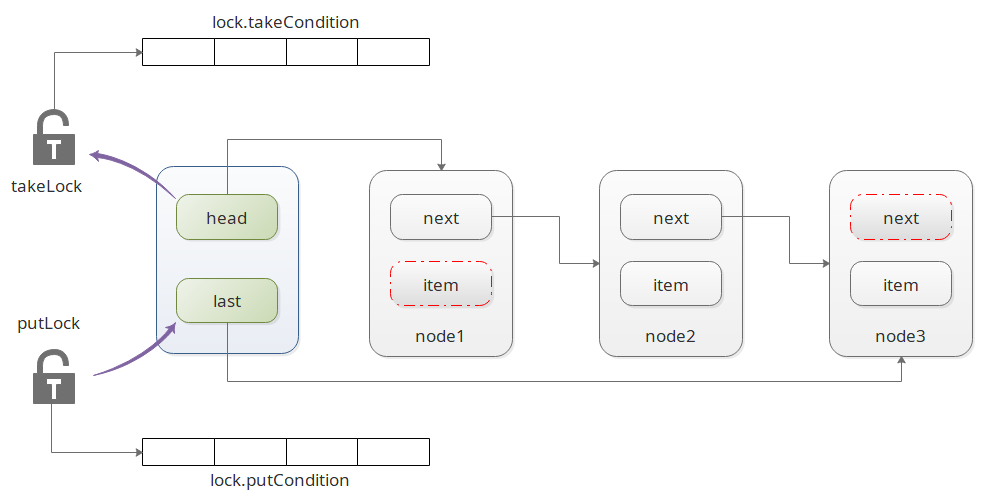本文将主要结合源码对 JDK 中的阻塞队列进行分析,并比较其各自的特点;
一、BlockingQueue 概述
说到阻塞队列想到的第一个应用场景可能就是生产者消费者模式了,如图所示;

根据上图所示,明显在入队和出队的时候,会发生竞争;所以一种很自然的想法就是使用锁,而在 JDK 中也的确是通过锁来实现的;所以 BlockingQueue 的源码其实可以当成锁的应用示例来查看;同时 JDK 也为我们提供了多种不同功能的队列:
- ArrayBlockingQueue :基于数组的有界队列;
- LinkedBlockingQueue :基于链表的无界队列(可以设置容量);
- PriorityBlockingQueue :基于二叉堆的无界优先级队列;
- DelayQueue :基于 PriorityBlockingQueue 的无界延迟队列;
- SynchronousQueue :无容量的阻塞队列(Executors.newCachedThreadPool() 中使用的队列);
- LinkedTransferQueue :基于链表的无界队列;
接下来我们就对最常用的 ArrayBlockingQueue 和 LinkedBlockingQueue 进行分析;
二、 ArrayBlockingQueue 源码分析
1. 结构概述
public class ArrayBlockingQueueextends AbstractQueue implements BlockingQueue , java.io.Serializable { final Object[] items; // 容器数组 int takeIndex; // 出队索引 int putIndex; // 入队索引 int count; // 排队个数 final ReentrantLock lock; // 全局锁 private final Condition notEmpty; // 出队条件队列 private final Condition notFull; // 入队条件队列 ...}
ArrayBlockingQueue 的结构如图所示:

如图所示,
ArrayBlockingQueue的数组其实是一个逻辑上的环状结构,在添加、取出数据的时候,并没有像ArrayList一样发生数组元素的移动(当然除了removeAt(final int removeIndex));- 并且由
takeIndex和putIndex指示读写位置; - 在读写的时候还有两个读写条件队列;
下面我们就读写操作,对源码简单分析:
2. 入队
public void put(E e) throws InterruptedException { checkNotNull(e); final ReentrantLock lock = this.lock; lock.lockInterruptibly(); try { while (count == items.length) // 当队列已满的时候放入 putCondition 条件队列 notFull.await(); enqueue(e); // 入队 } finally { lock.unlock(); }} private void enqueue(E x) { // assert lock.getHoldCount() == 1; // assert items[putIndex] == null; final Object[] items = this.items; items[putIndex] = x; // 插入队列 if (++putIndex == items.length) putIndex = 0; // 指针走一圈的时候复位 count++; notEmpty.signal(); // 唤醒 takeCondition 条件队列中等待的线程} 3. 出队
public E take() throws InterruptedException { final ReentrantLock lock = this.lock; lock.lockInterruptibly(); try { while (count == 0) // 当队列为空的时候,放入 takeCondition 条件 notEmpty.await(); return dequeue(); // 出队 } finally { lock.unlock(); }} private E dequeue() { // assert lock.getHoldCount() == 1; // assert items[takeIndex] != null; final Object[] items = this.items; @SuppressWarnings("unchecked") E x = (E) items[takeIndex]; // 取出元素 items[takeIndex] = null; if (++takeIndex == items.length) takeIndex = 0; count--; if (itrs != null) itrs.elementDequeued(); notFull.signal(); // 取出元素后,队列空出一位,所以唤醒 putCondition 中的线程 return x;} 三、LinkedBlockingQueue 源码分析
1. 结构概述
public class LinkedBlockingQueueextends AbstractQueue implements BlockingQueue , java.io.Serializable { private final int capacity; // 默认 Integer.MAX_VALUE private final AtomicInteger count = new AtomicInteger(); // 容量 transient Node head; // 头结点 head.item == null private transient Node last; // 尾节点 last.next == null private final ReentrantLock takeLock = new ReentrantLock(); // 出队锁 private final Condition notEmpty = takeLock.newCondition(); // 出队条件 private final ReentrantLock putLock = new ReentrantLock(); // 入队锁 private final Condition notFull = putLock.newCondition(); // 入队条件 static class Node { E item; Node next; Node(E x) { item = x; } }}
LinkedBlockingQueue 的结构如图所示:

如图所示,
LinkedBlockingQueue其实就是一个简单的单向链表,其中头部元素的数据为空,尾部元素的 next 为空;- 因为读写都有竞争,所以在头部和尾部分别有一把锁;同时还有对应的两个条件队列;
下面我们就读写操作,对源码简单分析:
2. 入队
public boolean offer(E e) { if (e == null) throw new NullPointerException(); final AtomicInteger count = this.count; if (count.get() == capacity) return false; // 如果队列已满,直接返回失败 int c = -1; Node node = new Node (e); // 将数据封装为节点 final ReentrantLock putLock = this.putLock; putLock.lock(); try { if (count.get() < capacity) { enqueue(node); // 入队 c = count.getAndIncrement(); if (c + 1 < capacity) // 如果队列未满,则继续唤醒 putCondition 条件队列 notFull.signal(); } } finally { putLock.unlock(); } if (c == 0) // 如果添加之前的容量为0,说明在出队的时候有竞争,则唤醒 takeCondition signalNotEmpty(); // 因为是两把锁,所以在唤醒 takeCondition的时候,还需要获取 takeLock return c >= 0;} private void enqueue(Nodenode) { // assert putLock.isHeldByCurrentThread(); // assert last.next == null; last = last.next = node; // 连接节点,并设置尾节点}
3. 出队
public E take() throws InterruptedException { E x; int c = -1; final AtomicInteger count = this.count; final ReentrantLock takeLock = this.takeLock; takeLock.lockInterruptibly(); try { while (count.get() == 0) { // 如果队列为空,则加入 takeCondition 条件队列 notEmpty.await(); } x = dequeue(); // 出队 c = count.getAndDecrement(); if (c > 1) notEmpty.signal(); // 如果队列还有剩余,则继续唤醒 takeCondition 条件队列 } finally { takeLock.unlock(); } if (c == capacity) // 如果取之前队列是满的,说明入队的时候有竞争,则唤醒 putCondition signalNotFull(); // 同样注意是两把锁 return x;} private E dequeue() { // assert takeLock.isHeldByCurrentThread(); // assert head.item == null; Node h = head; Node first = h.next; h.next = h; // help GC // 将next引用指向自己,则该节点不可达,在下一次GC的时候回收 head = first; E x = first.item; first.item = null; return x;} 四、ABQ、LBQ 对比
根据以上的讲解,我们可以逐步分析出一些不同,以及在不同场景队列的选择:
- 结构不同
- ABQ:基于数组,有界,一把锁;
- LBQ:基于链表,无界,两把锁;
- 内存分配
- ABQ:队列空间预先初始化,受堆空间影响小,稳定性高;
- LBQ:队列空间动态变化,受对空间影响大,稳定性差;
- 入队、出队效率
- ABQ:数据直接赋值,移除;队列空间重复使用,效率高;
- LBQ:数据需要包装为节点;需开辟新空间,效率低;
- 竞争方面
- ABQ:出入队共用一把锁,相互影响;竞争严重时效率低;
- LBQ:出入队分用两把锁,互不影响;竞争严重时效率影响小;
所以在这里并不能简单的给出详细的数据,证明哪个队列更适合什么场景,最好是结合实际使用场景分析;